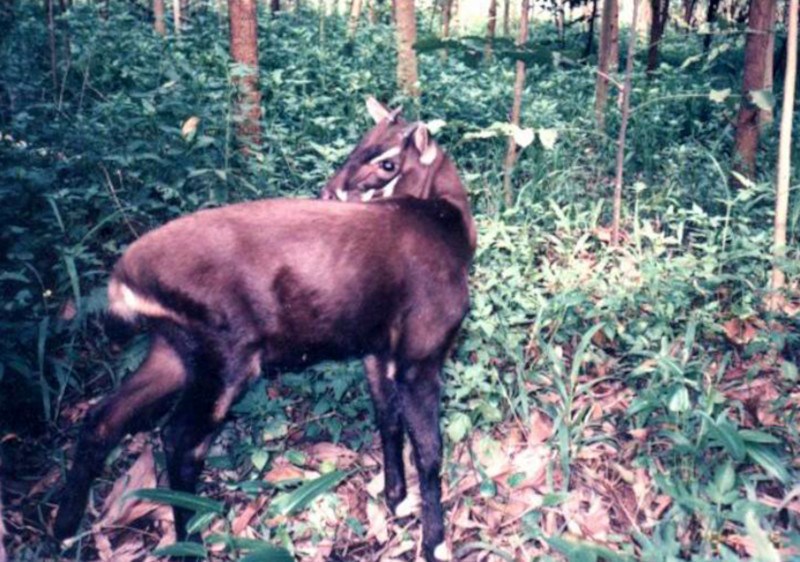Saola Facts
- The simple term of Saola does not do this creature justice. In fact, it serves as one of the common names for an astonishing species of moderate-sized mammal. However, this truly remarkable creature also goes by several other common names.
- These several alternate terms include the Vu Quang ox, spindlehorn, and the Vu Quang bovid. But, the fabulous animal also has one other alternate name, that really grabs the attention. That occurs because it’s sometimes referred to as the Asian Unicorn.
- This occurs due to a specific factor of its physical appearance. But, it’s also presently one of the most reclusive animals known to mankind. In addition, this incredible and unique species actually represents a genetic cousin of the cow, antelope, and goat.
- Furthermore, this surprisingly fascinating bovine also holds yet another remarkable status. In point of fact, the completely unique animal remained entirely unknown to the outside world until 1992. Its discovery at that time happened accidentally.
- In early November of 2014, an automated camera spotted a single Saola. That was the first sighting in almost 14 years. The IUCN lists it as Critically Endangered. The greatest threats to its existence consist of habitat loss and climate change.
Related Articles
Saola Physical Description
Firstly, one factor limits man’s knowledge of the animal. Unfortunately, fully reliable information about the Saola understandably remains exceedingly scarce. As a result, scientists obviously know only a few things about it for the moment.
However, based on the few individuals captured, some conclusions can be drawn. For one thing, mature adult specimens appear to average about 35 in (90 cm) at the shoulder. Furthermore, adults also appear to reach 5 ft (1.5 m) in total body length.
In addition, an adult weight for the fascinating mammal remains quite small. This seems to average roughly 220 lb (100 kg). Also, as far as researchers know, it does not display any particular degree of the principle of sexual dimorphism.
In addition, researchers remain uncertain about overall color patterns. Yet, the few observed individuals predominantly displayed similar markings. These consisted of a light to dark brown color, with scattered patches of white in the markings.
Furthermore, the most striking feature of the amazing Saola remains obvious to those who see it. It’s actually quite a distinctive physical trait. This holds true given the fact that it possesses a pair of comparatively long horns.
But, more startling facts remain about these features. The horns also grow relatively closely spaced and sharply angled in relation to the body. As a result, from a distance these appear as one horn, giving rise to its common name.
- Kingdom: Animalia
- Phylum: Chordata
- Class: Mammalia
- Order: Artiodactyla
- Family: Bovidae
- Genus: Pseudoryx
- Species: P. nghetenhensis
Saola Distribution, Habitat, and Ecology
One more thing stands out about the astounding species most commonly known as the Saola. That holds true because of the fact that, unfortunately, it appears to inhabit an extremely restricted part of the world. This region is also highly isolated.
It only appears to live in the Annamite Range of the countries of Vietnam and Laos, in Asia. There, however, the complete habitat type of this animal remains unconfirmed at this time. That’s simply because of the lack of sufficient sightings.
However, the bovine appears to primarily inhabit regions of wet deciduous and evergreen forests in the regions in which it appears. The fabulous mammal also has certain preferences. It seems to prefer to live in areas near rivers and valleys.
Regrettably, a precise count of the number of Saola seems to be impossible at this time. That’s simply due to the fact that most of its habitat continues to be virtually inaccessible. However, a projection concerning its numbers does exist.
Combining unconfirmed reports from local villagers, and physical evidence, researchers estimate that no more 300 still exist. The limited evidence available indicates that it remains active by both night and day, but rests during the heat of the day.
Also, the majority of sightings consist of lone individuals. Nevertheless, small groups of 3-7 have also been observed on occasion. It does appear to have an entirely herbivorous diet. Further, it seems to feed mainly on various local foliage.
Species Sharing Its Range
Check out our other articles on 7 Spectacular Geological Marvels of Europe, Golden Pheasant, Pearl Shoal Waterfall, Monkey Puzzle Tree, Indian Bullfrog, Giant Mesquite Bug, American Alligator

